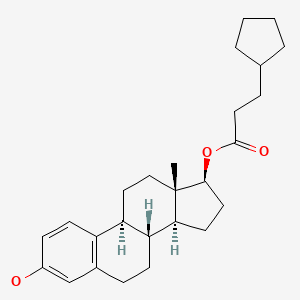CASRN: 313-06-4

Drug Levels and Effects
Summary of Use during Lactation
Estradiol cypionate has not been studied during breastfeeding. However, a similar drug, estradiol valerate, has been used to suppress lactation, usually in combination with testosterone. Generally, estradiol cypionate should be avoided in mothers wishing to breastfeed, especially if started before the milk supply is well established at about 6 weeks postpartum. The decrease in milk supply can happen over the first few days of estrogen exposure.[1]
Drug Levels
Maternal Levels. Relevant published information on estradiol cypionate was not found as of the revision date. However, estradiol appears in breastmilk in small amounts after administration by other routes.[2,3]
Infant Levels. Relevant published information was not found as of the revision date.
Effects in Breastfed Infants
Relevant published information was not found as of the revision date.
Effects on Lactation and Breastmilk
Another injection ester form of estradiol, estradiol valerate was previously used therapeutically to suppress lactation, usually in combination with testosterone.[4-6]
A retrospective cohort study compared 371 women who received high-dose estrogen (either 3 mg of diethylstilbestrol or 150 mcg of ethinyl estradiol daily) during adolescence for adult height reduction to 409 women who did not receive estrogen. No difference in breastfeeding duration was found between the two groups, indicating that high-dose estrogen during adolescence has no effect on later breastfeeding.[7]
Alternate Drugs to Consider
References
- 1.
- Moses-Kolko EL, Berga SL, Kalro B, et al. Transdermal estradiol for postpartum depression: A promising treatment option. Clin Obstet Gynecol 2009;52:516-29. [PMC free article: PMC2782667] [PubMed: 19661765]
- 2.
- Nilsson S, Nygren KG, Johansson ED. Transfer of estradiol to human milk. Am J Obstet Gynecol 1978;132:653-7. [PubMed: 717472]
- 3.
- Perheentupa A, Critchley HO, Illingworth PJ, McNeilley AS. Enhanced sensitivity to steroid-negative feedback during breast-feeding: Low-dose estradiol (transdermal estradiol supplementation) suppresses gonadotropins and ovarian activity assessed by inhibin B. J Clin Endocrinol Metab 2000;85:4280-6. [PubMed: 11095468]
- 4.
- Louviere RL, Upton RT. Evaluation of Deladumone OB in the suppression of postpartum lactation. Am J Obstet Gynecol 1975;121:641-2. [PubMed: 1090174]
- 5.
- Morris JA, Creasy RK, Hohe PT. Inhibition of puerperal lactation. Double-blind comparison of chlorotrianesene, testosterone enanthate with estradiol valerate and placebo. Obstet Gynecol 1970;36:107-14. [PubMed: 4912251]
- 6.
- Iliya FA, Safon L, O'Leary JA. Testosterone enanthate (180 mg.) and estradiol valerate (8 mg.) for suppression of lactation: A double-blind evaluation. Obstet Gynecol 1966;27:643-5. [PubMed: 5949195]
- 7.
- Jordan HL, Bruinsma FJ, Thomson RJ, et al. Adolescent exposure to high-dose estrogen and subsequent effects on lactation. Reprod Toxicol 2007;24:397-402. [PubMed: 17531440]
Substance Identification
Substance Name
Estradiol Cypionate
CAS Registry Number
313-06-4
Drug Class
Breast Feeding
Lactation
Milk, Human
Estrogens
Hormones
Disclaimer: Information presented in this database is not meant as a substitute for professional judgment. You should consult your healthcare provider for breastfeeding advice related to your particular situation. The U.S. government does not warrant or assume any liability or responsibility for the accuracy or completeness of the information on this Site.
Publication Details
Publication History
Last Revision: August 15, 2023.
Copyright
Attribution Statement: LactMed is a registered trademark of the U.S. Department of Health and Human Services.
Publisher
National Institute of Child Health and Human Development, Bethesda (MD)
NLM Citation
Drugs and Lactation Database (LactMed®) [Internet]. Bethesda (MD): National Institute of Child Health and Human Development; 2006-. Estradiol Cypionate. [Updated 2023 Aug 15].